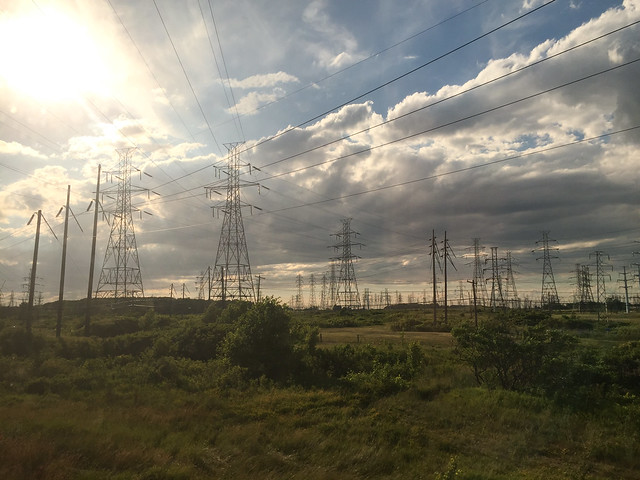Finally, it's clear: we’ll be living in an unpredictable and frankly scary world for the rest of this decade thanks to our dear American friends’ impulsive, power-hungry and distinctly unfriendly leader.
Canadian priorities have completely shifted in just a few weeks. Canadian sovereignty is on the line. Deep economic integration with the U.S., seen as key to prosperity and safety in the past, is being used against us. Canadians are checking for a maple leaf when buying groceries — they’re glad to hear about Kentucky bourbon being taken off the shelves — and very soon, they’ll expect our leaders to unveil a nation-wide strategy for major economic growth independent of the U.S.
There will be a vigorous debate on which direction that strategy should take.
The rest of the world is moving at pace into what the International Energy Agency calls the Age of Electricity. The global transition to clean energy is accelerating. In 2024, global investment in clean energy beat out fossil fuels, $2 trillion to $1 trillion. Investment in low-carbon solutions — like electrified transport and renewables — grew by 11 per cent, hitting a record $2.1 trillion. All driven by dramatic declines in cost of new power generation and electrification technology.
President Trump sees this as a threat to U.S. economic power and is actively trying to take the U.S. in the opposite direction.
With our abundant natural resources — including our ability to generate lots of clean, low-cost electricity to power the industries of the future — Canada is positioned to thrive in this emerging clean economy.
Canada’s largest provincial economies are scaling up their supplies of electricity, and electrifying their buildings and transportation systems. Quebec Hydro is investing tens of billions in expanding hydro power production, building out its wind power industry and modernizing its power grid. BC Hydro is completing the Site C dam this year and had a very successful call for new power. Ontario is planning to invest heavily in nuclear and seeking advice on demand side management improvements.
Calls to quickly break down trade barriers and scale up trade between provinces are highlighting a major economic growth opportunity that has, until now, been deemed politically unfeasible: deeply integrating our provincial power grids. Instead of a patchwork of “power islands,” a deeply connected cross-Canada grid.
Take Alberta and B.C. for example. Alberta could build out wind and solar, and connect that variable power with B.C.’s big hydro dams, which can act like giant batteries that produce when the power is needed most. Both provinces get more value from their respective power generation assets.
This supply of affordable and reliable clean electricity is also key to attracting investment in the production of goods and services that modern net-zero economies around the world are demanding. Readily available clean electricity was a contributing factor in the Volkswagen Group’s $7-billion decision to build its first North American-based battery manufacturing plant in Ontario and Honda’s $15-billion milestone investment in Canada’s first comprehensive electric vehicle (EV) supply chain, creating thousands of jobs.
In 2025, this is how we grow the economy without relying on increased trade with the U.S.
And, there will be loud voices urging Canadians to go another way.
Powerful incumbent oil and gas industry players have begun calling on governments to expand oil and gas infrastructure. Last week — despite several years of profits in the absence of growth and no active pipeline proposals — its main industry association called for the rollback of regulations it claims are stopping pipeline development. One oil and gas CEO even argued for pipelines to be declared “in the national interest."
While this moment calls for decisiveness, Canada must be strategic and responsible about which projects and industries we develop. We should avoid kneejerk investments we’ll regret, including tax-payer backstopped pipelines that risk becoming stranded assets not long after coming online.
New energy infrastructure — whether an upstream production facility, pipeline, LNG terminal, or refinery — take several years to plan and several more to complete. This has not been happening lately because investors are looking at the same scenarios as us, which suggest global oil and gas demand will peak and begin its decline in the next decade (potentially as early as 2030).
Modernizing our electricity grid, building out renewables and other clean energy sources, and shifting our domestic energy demand from oil and gas to electricity will be Canada’s next serious drivers of jobs and economic development. Ideally, Canada’s electricity grid is clean, modern and well-connected, powering as many aspects of everyday life as possible — from the cars we drive, to how we heat and cool our homes, to the industries that provide jobs and prosperity across our country.
A coordinated national policy of clean electrification is the nation-building exercise we need right now. Electrification is the only overarching policy I know of that simultaneously supports economic prosperity, creates jobs, improves health outcomes, provides affordable energy, reduces carbon emissions, and helps Canadians become more resilient — to the economic impacts of trade disputes, and the physical and economic impacts of climate change.
Clean Energy Canada research shows a household in Toronto that switches its gas cars for EVs, swaps out its gas appliances, installs a heat pump, and makes modest energy efficiency upgrades could cut $550 off its monthly bills, even accounting for upfront costs. A similar house in Vancouver could save $777.
On jobs: Pembina Institute modelling shows that in Alberta, despite job losses in oil and gas, if governments embrace the clean economy, there will be net job growth – with 33,000 jobs added by 2030, and 287,000 by 2050. These are jobs in clean transportation; low-carbon buildings; direct air capture; clean electricity; biofuels; low-carbon manufacturing; and hydrogen and carbon capture and storage. Depending on the cost and availability of CCUS and direct air capture technologies during this timeframe, these numbers could be even higher.
If there’s ever been a time to bolster Canada’s national security through an energy project that makes us more prosperous, healthier and more resilient to an increasingly turbulent world, while reducing emissions and doing our part to address the climate crisis, this is it – and the project is clean power.
Published in Canada's National Observer (March 19, 2025)







